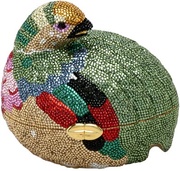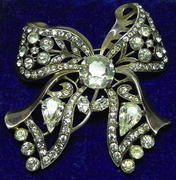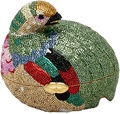
The Duke and Duchess of Windsor had one of the most melodramatic love stories of the 20th century, right up there with John Lennon and Yoko Ono. In the early 1930s, the Prince of Wales became smitten with international socialite Wallis Warfield Simpson—drawn by her sharp wit, imagination, and generosity, even though she was still married to her second husband.
Less than a year after he became King Edward, in 1936, he shocked all of England by abdicating his throne, throwing away his reign as King of Britain and Head of the Commonwealth, just so he could marry “the love of his life,” an American woman who’d been divorced twice. His brother, George VI, who became king, created the Duke of Windsor title for him.
The Windsors documented their passionate love affair throughout the rest of their lives by trading extravagant and deeply personal jewelry—many of these tokens of affection will be auctioned off on November 30, 2010, at Sotheby’s in London. Of course, with all the gold, diamonds, emeralds, and rubies involved, the auction prices are bound to reach the stratosphere—some are expected to sell in the millions. Nonetheless, it’s a stunning collection to gawk at, and it’s hard not to get swept up in the overt sentimentality of it all.
“The nice thing is, yes, there is the jewelry, wonderful jewelry, which covers the great Cartier jewels,” says Alexandra Rhodes, the senior director of Sotheby’s in London. “But equally, it covers a lot of the jewels with inscriptions and dates which obviously follow the love story of the Windsors.”
The romance is spelled out in a chapter of the recent book, “Famous Jewelry Collectors,” by Rhodes and her former colleague Stefano Papi. Years before they were married, the Prince fawned over Wallis, lavishing her with ornate jewelry, many pieces of which he had specially commissioned for her. She responded in kind. These gifts of platonic friendship are thought to have been coded with secret meaning.

In 1957, Cartier created this ruby-crowned 20th-anniversary brooch for the duchess. Like many of her pieces, it was a gift from her husband, the duke.
For example, a gold cross-shaped pendant Edward gifted to Wallis in 1934 was inscribed with “WE are too,” believed to mean “Wallis and Edward are also in love.” That cross was attached to a 1935 diamond Cartier bracelet, eventually adorned with eight other crosses, all of them set with jewels and engraved to commemorate life events like the couple’s wedding, her appendicitis operation, and even an assassination attempt on the king.
In the early days of their courtship, Wallis also gave Edward a token of their secret romance—a gold cigarette case featuring a map of Europe and North Africa. Enameled lines show the route of trips the two took together, and gemstones mark special places. Sometimes, Rhodes explains, the jewelry was inscribed during a time of turmoil, when it seemed the forces of their lives would keep them apart. More than one piece is engraved with the words “hold tight.”
But these romantic, indulgent gifts didn’t end after the two were married. In fact, the couple doted on each other until the duke passed away in 1972. In addition, because the Duchess of Windsor was considered a fashion trendsetter, when the duke had a piece of jewelry commissioned for her, she would then have a dress designed to match it.
For their 20th anniversary, the duke gave the duchess a heart-shaped diamond brooch with an emerald pattern script “W” and “E” intertwined and a ruby crown on the top. Edward always regretted that Wallis was never bestowed the designation of Her Royal Highness, so the crown was a part of their lifelong love code spoken in jewelry.

This diamond bracelet featuring numerous bejeweled crosses was made by Cartier between 1934 and ’44.
“Take the Cartier pavé-set cufflinks, which Wallis gave to the then Prince of Wales in 1935,” Rhodes says. “They are very unique because she’s obviously asked the designers to either put an ‘E’ or a ‘W’ on each of the links. This stands for Edward and Wallis, or Edward of Wales. The letters could stand for him alone or for them both. They were often called ‘WE’, and they called themselves ‘The Royal WE.’
“She had those specially designed for him,” Rhodes continues. “Then around the sides or around the backs, she had engraved significant dates, including her birthday. When he put his pair of cufflinks on, it would remind him when her birthday was coming up, that he needed to buy some extravagant present, I think.”
Outside of this blatant mushiness, the Duke of Windsor gave the duchess many unengraved pieces that stand out simply for their creative designs and craftsmanship, including much of Cartier’s famous “great cat” menagerie. This collection was inspired by high-end jewelry director Jeanne Toussaint, who was nicknamed “The Panther” by her good friend, and employer, Louis Cartier because of her fascination with panthers, whose skins she enjoyed as rugs. Toussaint worked with Cartier’s designer Peter Lemarchand to design the jewelry line.
The Windsors commissioned the first, a 3D gold panther pin embossed with black enamel and sitting on an emerald barrel. Wallis continued to collect these cats; many, like the onyx and diamond bracelet in the auction, wrap around the wrist in a slinky, organic way. Rhodes says she believes Wallis was so fond of these pieces, “because at the time she was the first to have a cat jewel.”

A masterpiece of the duchess’s collection is this onyx-and-diamond panther bracelet, 1952, part of Cartier’s “great cat” menagerie.
“They are very beautifully made, very finely designed,” Rhodes says. “They’re also very flexible; they literally move. For the designs that Cartier did, like the one in the auction, he used to go to the zoo in France where he would watch the panthers pacing so he’d get the movement. All these cat jewels look like the real thing, striding around, almost about to pounce. It was very much a jewel that had style and taste. It would be a jewel that you would want to have.”
So are these two almost-royal lovers to blame for the romantic mystique surrounding diamonds and jewelry? That would be hard to prove, but the auction does offer a glimpse into the Windsors’ rarefied, glamorous world—the adoring inscriptions, the crosses, the cigarette case, the love heart, the cufflinks, the cats, and even a stunning bejeweled ’40s flamingo the ever-elegant Wallis wore to all the major balls in Paris.
“In the war days, jewels were often unmounted and remounted,” Rhodes says, describing the flamingo. “We’ve got a drawing of the original design, which Cartier kindly allowed us to reproduce in our catalog, which shows that several pieces of her jewelry were unmounted to make this one. So you not only have a wonderful bird jewel inspired by Jeanne Touissant, but you’ve also got the fact that jewels from the duchess’s own collection were used in conjunction with other jewels and gemstones from Cartier to create it. That, to my mind, is a very unique piece.”
In November, bidders will have their chance to decide just what all that history, artistry, and romantic display of affection is worth.
The Duchess of Windsor’s jewels will be on view at Sotheby’s in New York from October 29 – November 2 and in London from November 26 until the auction date of November 30, 2010.
(All photos courtesy Sotheby’s)

 Purse Perfection: Judith Leiber on Faberge, Rhinestones, and Her Favorite First Ladies
Purse Perfection: Judith Leiber on Faberge, Rhinestones, and Her Favorite First Ladies
 Hidden Gems: Lost Hollywood Jewelry Trove Uncovered in Burbank Warehouse
Hidden Gems: Lost Hollywood Jewelry Trove Uncovered in Burbank Warehouse Purse Perfection: Judith Leiber on Faberge, Rhinestones, and Her Favorite First Ladies
Purse Perfection: Judith Leiber on Faberge, Rhinestones, and Her Favorite First Ladies Rhinestone Dynasty: Karl Eisenberg Talks About His Family's Costume Jewelry
Rhinestone Dynasty: Karl Eisenberg Talks About His Family's Costume Jewelry Diamond JewelryAccording to James Bond author Ian Fleming, diamonds are forever. For Maril…
Diamond JewelryAccording to James Bond author Ian Fleming, diamonds are forever. For Maril… Royalty CollectiblesIf you were one of the thousands who bought a porcelain plate to commemorat…
Royalty CollectiblesIf you were one of the thousands who bought a porcelain plate to commemorat… Mari Tepper: Laying it on the Line
Mari Tepper: Laying it on the Line Nice Ice: Valerie Hammond on the Genteel Charm of Vintage Canadian Costume Jewelry
Nice Ice: Valerie Hammond on the Genteel Charm of Vintage Canadian Costume Jewelry How Jim Heimann Got Crazy for California Architecture
How Jim Heimann Got Crazy for California Architecture Modernist Man: Jock Peters May Be the Most Influential Architect You've Never Heard Of
Modernist Man: Jock Peters May Be the Most Influential Architect You've Never Heard Of Meet Cute: Were Kokeshi Dolls the Models for Hello Kitty, Pokemon, and Be@rbrick?
Meet Cute: Were Kokeshi Dolls the Models for Hello Kitty, Pokemon, and Be@rbrick? When the King of Comedy Posters Set His Surreal Sights on the World of Rock 'n' Roll
When the King of Comedy Posters Set His Surreal Sights on the World of Rock 'n' Roll How One Artist Makes New Art From Old Coloring Books and Found Photos
How One Artist Makes New Art From Old Coloring Books and Found Photos Say Cheese! How Bad Photography Has Changed Our Definition of Good Pictures
Say Cheese! How Bad Photography Has Changed Our Definition of Good Pictures Middle Earthenware: One Family's Quest to Reclaim Its Place in British Pottery History
Middle Earthenware: One Family's Quest to Reclaim Its Place in British Pottery History Fancy Fowl: How an Evil Sea Captain and a Beloved Queen Made the World Crave KFC
Fancy Fowl: How an Evil Sea Captain and a Beloved Queen Made the World Crave KFC
Leave a Comment or Ask a Question
If you want to identify an item, try posting it in our Show & Tell gallery.